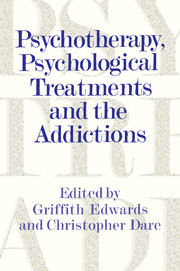Book contents
- Frontmatter
- Contents
- List of contributors
- Psychotherapy and psychological treatments of substance problems: generalism, specialism and the building of bridges
- Acknowledgements
- Part one Backgrounds to therapeutic understanding
- Part two Treatments
- 5 Psychotherapy: why do some need more and some need less?
- 6 Addictive behaviour: the next clinic appointment
- 7 Advances in families and couples therapy
- 8 Solution focused brief therapy: a co-operative approach to work with clients
- 9 Recent developments in cognitive and behavioural therapies
- 10 Cognitive and behavioural treatments for substance misuse
- 11 Motivational issues in the treatment of addictive behaviour
- 12 Can ‘stages of change’ provide guidance in the treatment of addictions? A critical examination of Prochaska and DiClemente's model
- 13 Group therapy and the addictions
- 14 Alcoholics Anonymous as mirror held up to nature
- 15 How therapeutic communities work
- Part three Postscript
- Index
12 - Can ‘stages of change’ provide guidance in the treatment of addictions? A critical examination of Prochaska and DiClemente's model
from Part two - Treatments
Published online by Cambridge University Press: 05 August 2016
- Frontmatter
- Contents
- List of contributors
- Psychotherapy and psychological treatments of substance problems: generalism, specialism and the building of bridges
- Acknowledgements
- Part one Backgrounds to therapeutic understanding
- Part two Treatments
- 5 Psychotherapy: why do some need more and some need less?
- 6 Addictive behaviour: the next clinic appointment
- 7 Advances in families and couples therapy
- 8 Solution focused brief therapy: a co-operative approach to work with clients
- 9 Recent developments in cognitive and behavioural therapies
- 10 Cognitive and behavioural treatments for substance misuse
- 11 Motivational issues in the treatment of addictive behaviour
- 12 Can ‘stages of change’ provide guidance in the treatment of addictions? A critical examination of Prochaska and DiClemente's model
- 13 Group therapy and the addictions
- 14 Alcoholics Anonymous as mirror held up to nature
- 15 How therapeutic communities work
- Part three Postscript
- Index
Summary
Introduction
Few workers in the addictions field can fail to have noticed the ‘stages of change’ model of Prochaska and DiClemente (Prochaska and DiClemente, 1986; Prochaska et al., 1992). The model appears to offer a general, comprehensive, and theoretically coherent account of how people change their behaviour. It clearly has immense intuitive appeal to teachers, practitioners and researchers in the addictions field. With one exception (Davidson, 1992), commentators have been unanimous in their praise and enthusiasm for the model. Orford (1992) likened the development of the model to a Kuhnian paradigm shift, and Stockwell (1992) compared the reaction of some of his colleagues to the recent announcement that a fifth stage of change had been identified to the awe that might accompany the discovery of a new planet.
This chapter provides a critical assessment of the stages of change model. It addresses two key assumptions of the model: (1) that change in addictive behaviour involves movement through a sequence of stages; and (2) that different processes of change are emphasised in different stages and promote progression through the sequence. The questionnaire instruments designed to assess the stages and processes of change are also examined. The chapter does not attempt to give an exhaustive review of the literature in this area. It focuses on Prochaska and DiClemente's own published papers. Related work on readiness to change (Rollnick et al., 1992; Heather et al., 1993) is not discussed, though some of the comments also apply to that approach. Nor do we compare the stages of change model with other decision-making models that have been applied to addictive behaviours such as the Theory of Reasoned Action/Planned Behaviour and the Subjective Expected Utility Model (Sutton, 1987, 1989). Most applications of the stages of change model have been to smoking. Orford (1992) has suggested that decision-making approaches may be less applicable to alcohol and drug abuse.
The stages of change
The stages of change model
The stages of change have been described in terms of a revolving door metaphor, as depicted in Figure 12.1. As an aside, it is worth noting that the metaphor is not strictly accurate since a person entering a revolving door stays in the same compartment ('stage’) until exiting.
- Type
- Chapter
- Information
- Psychotherapy, Psychological Treatments and the Addictions , pp. 189 - 205Publisher: Cambridge University PressPrint publication year: 1996
- 49
- Cited by



